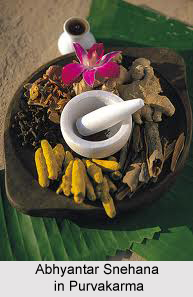 Abhyantar snehana in Purvakarma actually means internal oleation. This internal process of snehana comprises taking prescribed amounts of warm, herbalized ghee that is called tikta ghrita, the very first thing in the morning and again in late afternoon on an empty stomach. With time, Ayurvedic physician eventually increases the prescribed dosage on the basis of the strength of the patient`s digestive agni. The patient is advised not to eat until the ghee is digested that is signalled by the return of appetite.
Abhyantar snehana in Purvakarma actually means internal oleation. This internal process of snehana comprises taking prescribed amounts of warm, herbalized ghee that is called tikta ghrita, the very first thing in the morning and again in late afternoon on an empty stomach. With time, Ayurvedic physician eventually increases the prescribed dosage on the basis of the strength of the patient`s digestive agni. The patient is advised not to eat until the ghee is digested that is signalled by the return of appetite.
In Ayurveda, for the main eliminative procedures, the patient is given both internal and external oleation every single day. It is the preparatory stage of the elimination process. These treatments of abhyantar snehana or internal oleation continue up to seven days, it is the minimum time required for the oleaginous substances to reach and saturate all the seven dhatus in Ayurveda. Again after the seventh day, oleation becomes counterproductive as because there is nowhere else for the oil to go. If the process is continued, it starts to collect in the dhatus as saturated fat and depletes the dhatu agnis. Meanwhile, aama forms and blocks channels and inhibits vata`s effective movement.
In addition, over-oleating may have some more effects in the body. Secondary effects of over oleating may include poor elimination, abdominal bloating and hardened faecal matter. That is why the major eliminative procedures of Panchakarma are always administered after the seventh day of snehana. The internal application of Purvakarma or abhyantar snehana helps in making the body well lubricated both internally as well as externally. Its completion indicates that the oil has saturated all the seven dhatus. After the procedure of abhyantar snehana gets over, the skin displays a shiny and soft appearance and its smell becomes slightly unctuous. There are certain classical signs that indicate the completion of internal oleation. It also enhances the elimination process of the body. Removal is healthy and normal. Secretions from the eyes, ears and nose shine slightly and as a result of this entire process, the skin and hair become softer.
The herbalized ghee is utilized for this procedure of abhyantar snehana. Its amazing penetrating qualities make it more effective for internal oleation. It spreads thoroughly and that makes it easier for the tissues to absorb. Herbalized ghee has remarkable properties as a medicinal and nutritive substance. It does not elevate the cholesterol level in the body.
Abhyantar snehana in Purvakarma reduces excessive acidity both in the tissues and in the digestive tract of the body.




















